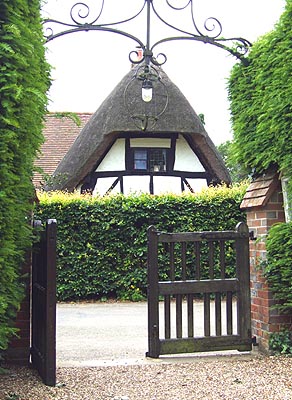 |
 |
|||
|
|
Brightwalton, originally Beorghtwaldington, is Saxon for 'Beorghwald's People's Town (ie Farm)'. Popular Victorian name variations were Brickleton and Brightwaltham. After the Battle of Hastings, the village was given to Battle Abbey in Sussex. They built a small monastic grange with a chapel in the moat still visible near the old churchyard, between Manor Farm and the Street. The monks had the right to undertake the only brewing and baking in Brightwalton there, and also to erect a gallows. Most of the parish was taken up with sheep grazing and woodland for pigs at this time. In 1293, the local swineherd, Richard Young got in trouble for letting the monks' pigs perish, whilst pasturing too many of his own. Some common land was enclosed in 1721, but Holt and Boarded House Common remained. Two ponds supplied water for agriculture, animals and people. Dunmore Pond dates from at least 1240 and had the monks' medieval fish pond nearby. Black Pond was filled in in 1953. The medieval practice of archery, in case of war, is remembered at Butts Furlong, near the village hall. However, it wasn't used much in the late 1340s, when the Black Death devastated Brightwalton. In 1352, it was recorded that the occupants of some fifteen cottages there were "all in the hands of the Lord". During Tudor times, the Young family were still in the village. They provided a number of rectors and John and Agnes Young have a brass memorial plaque (1476) in the church. The Dissolution of the Monasteries meant that the manor was purchased by Sir William Essex of Lambourn Place. He rented it out to the Braybrooke family from Abingdon, who acted as lords of the manor. James Braybrooke also had a brass in the old church, but only a single coat of arms survives from it. There are still many attractive cottages from this time to be seen in the village. During the Civil War, it is believed there was an armed skirmish in the Holt area of Brightwalton, when Royalist soldiers were stationed there and in Farmborough. Five bodies excavated at the old Marquis of Granby PH in 1887 were thought to be some of those killed. Two of them were headless! At the end of the 17th century, the manor was purchased by Sir Samuel Eyre, Justice of the King's Bench, and members of his family were rectors at the church for fifty-six years, from 1722 to 1778. In 1800, the manor was bought by the Wroughtons, who inherited and lived at Woolley Park in Chaddleworth a hundred years later. Brightwalton was quite cut off at this time, until John Jackson set up a carrier business there around 1830. He travelled to Newbury three times a week and would take passengers as well as goods, so the villagers could link up with coaches to all over the country. In 1861, Philip Wroughton pulled down the little old Norman church (whose footings can be seen in the old churchyard) as it was in a state of disrepair and paid for a new one to be built. Two years later the present building was completed by GE Street at a cost of £4,000. Largely based on the work of Osment, Sayer & Stephens (2002).
|
|||
| © Nash Ford Publishing 2011. All Rights Reserved. | ||||



 Brightwalton
Brightwalton